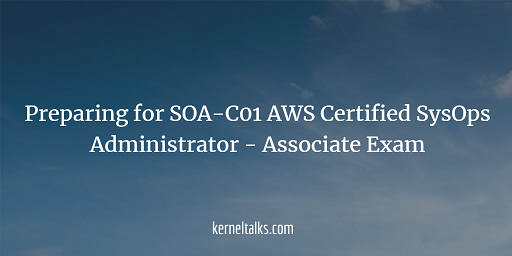A quick article on how to prepare for SOA-C01 AWS Certified SysOps Administrator – Associate Exam

It’s a short article on AWS Sysops Associate certification exam. These are extracts from my personal experience which might help you in clearing the exam.
Sysops exam is aimed at you have good knowledge about a few core services like EC2, Cloudformation, Cloudwatch, etc. and AWS CLI. There are many references to CLI options or commands. This exam does not judge you for knowing all AWS services like Solution Architect one but it does check you for a few core services with deeper knowledge.
You must have already gone through the AWS certification page for details about this exam. Let me jot it down for your quick reference.
- Total of 65 questions
- Cost $150
- Exam guide
- Sample questions
- The exam result will appear on the screen as soon as you submit the exam.
- Questions vary in length (short/long) but time should not be constraint here as it could be in SA professional exam.
Topics you should study
Its recommended that you should at least consider clearing AWS certified solution architect exam before appearing this one. It will firm your AWS foundational knowledge for many services and help you get a grip on the learning path for Sysops.
Below are few service which you should deep dive –
- Cloudwatch
- Built-in and custom matrics
- AWS CLI commands and options
- Deep dive for custom matrics
- Cloudwatch console (what, when, where)
- Cloudwatch alarm deep dive
- Cloudformation
- All template references and their use cases
- How to re-use templates in other regions/accounts etc.
- Create, update, and delete template/stack. All its stages, CLI options, console, etc.
- EC2
- Pricing classes, how EC2 is billed and use cases
- I did not get many questions on EC2 apart from identifying the correct EC2 class in a given scenario
- Spot block
- System status checks and Instance status checks
- Autoscaling group deep dive
- Root cause analysis of EC2 termination on launch
- AWS Systems Manager deep dive
- AWS Inspector
- S3
- Different classes and use cases
- Encryption
- Security using ACL and bucket policies
- CORS and CRR
- Cross account Access control & signed URLs
- Website hosting basics
- MFA delete deep dive along with CLI options
- Versioning fundamentals
- RDS, Redshift
- I got the only couple of questions on RDS
- Enhanced monitoring
- Multi-AZ and read replica deep dive
- How to DR, HA, and FT in RDS
- Redshift enhanced VPC routing
- Redshift basics
- VPC and networking
- VPC flow logs deep dive
- Security group, NACLs, and route tables
- NAT, IG, VPC Endpoints
- Public, private subnets
- VPC peering process
- VPC, On-prem connectivity
- On-prem extension services for AWS
- WAF, Cloudfront
- Assorted
- IAM, KMS deep dive
- AWS Trusted advisor
- AWS config deep dive
- Shared responsibility model
- AWS certificate manager
- ELB – ALB, NLB and Classis LB
- AWS Beanstalk, AWS Op works
- SNS, SQS, Lambda
- Health dashboards
- Billing tools
Online courses
I relied on only one course for this exam since I backpacked foundational, associate, and professional level certifications before this one. So a few refreshers were required. Here is a list of online courses from well-known websites –
- AWS Certified SysOps Administrator – Associate (SOA-C01) by LA
- AWS Certified SysOps Administrator – Associate 2020 by ACG
- SysOps Administrator – Associate Certification Preparation for AWS by CA
- Bonus: Exam Readiness: AWS Certified SysOps Administrator – Associate Free by AWS
Practice tests
Here is a list of practice tests that you can take online to test your knowledge. If you are already certified you can get a free practice test from AWS itself. You have to claim it under benefits in your AWS certification portal.
- AWS certified sysops administrator associate practise exam by Tutorials DOJO
- AWS Certified SysOps Administrator Associate Practice Exams on Udemy
- AWS Certified SysOps Administrator Associate by Whizlabs
I am linking here my last day revision notes which may help you in your preparation.
Share Your Comments & Feedback: